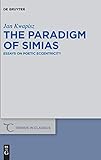The Paradigm of Simias : Essays on Poetic Eccentricity / Jan Kwapisz.
Material type: TextSeries: Trends in Classics - Supplementary Volumes ; 75Publisher: Berlin ; Boston : De Gruyter, [2019]Copyright date: ©2019Description: 1 online resource (X, 193 p.)Content type:
TextSeries: Trends in Classics - Supplementary Volumes ; 75Publisher: Berlin ; Boston : De Gruyter, [2019]Copyright date: ©2019Description: 1 online resource (X, 193 p.)Content type: - 9783110635935
- 9783110636048
- 9783110640106
- PA4410.S65 K93 2019
- online - DeGruyter
- Issued also in print.
| Item type | Current library | Call number | URL | Status | Notes | Barcode | |
|---|---|---|---|---|---|---|---|
 eBook
eBook
|
Biblioteca "Angelicum" Pont. Univ. S.Tommaso d'Aquino Nuvola online | online - DeGruyter (Browse shelf(Opens below)) | Online access | Not for loan (Accesso limitato) | Accesso per gli utenti autorizzati / Access for authorized users | (dgr)9783110640106 |
Browsing Biblioteca "Angelicum" Pont. Univ. S.Tommaso d'Aquino shelves, Shelving location: Nuvola online Close shelf browser (Hides shelf browser)

|

|

|

|

|

|

|
||
| online - DeGruyter Schreiben in Archipelen : Kleine Formen in post-kolonialen Kontexten / | online - DeGruyter Die Handschriften aus der Judäischen Wüste : Die Texte außerhalb Qumrans. Einführung und deutsche Übersetzung / | online - DeGruyter Graeca – Byzantina – Neograeca : Schriften zur griechischen Sprache und Literatur / | online - DeGruyter The Paradigm of Simias : Essays on Poetic Eccentricity / | online - DeGruyter Die Kultivierung des Geschmacks : Eine Transformationsgeschichte der kulinarischen Sinnlichkeit / | online - DeGruyter Praxishandbuch Recht für Bibliotheken und Informationseinrichtungen / | online - DeGruyter Jahreszeitenreliefs aus dem Sonnenheiligtum des Königs Ne-User-Re / |
Habilitation University of Warsaw 2017.
Frontmatter -- Contents -- Acknowledgements -- Introduction: The Paradigm of Simias -- 1. The Three Preoccupations of Simias of Rhodes -- 2. Laevius’ Broken Wing and the Banquet of Riddlers -- 3. Optatian Porfyry and the Order of Court Riddlers -- 4. The Invention of the Figure Poem in Byzantium -- Appendix: A New Alexandria and its Little Museum -- Bibliography -- Index of Sources and Passages Cited -- General Index
restricted access online access with authorization star
http://purl.org/coar/access_right/c_16ec
This book’s concern is with notoriously obscure ancient poets-riddlers, whom it argues to have been an essential, albeit necessarily marginal, element of the literary landscape of Antiquity, which, in addition, exerted subtle yet lasting influence on European culture. The three first essays in this book trace a direct line of influence between the early Hellenistic scholar-poet Simias of Rhodes, the late Republican Roman experimentalist Laevius and Constantine the Great’s virtuoso panegyrist Optatian Porfyry, whereas the fourth essay discusses the preservation and transformation of the model invented by Simias in Byzantium. The Appendix reflects on the triumph of this intellectual paradigm in Neo-Latin Jesuit education by investigating the case of a peripheral yet highly influential Central European college at the turn of the sixteenth and seventeenth centuries. This book is at once a contribution to the scholarship on the reception of Hellenistic poetry and to the study of ancient ‘technopaegnia’ (i.e. playful poetry) and their cultural influence in Antiquity, Byzantium and post-mediaeval Europe.
Issued also in print.
Mode of access: Internet via World Wide Web.
In English.
Description based on online resource; title from PDF title page (publisher's Web site, viewed 28. Feb 2023)


